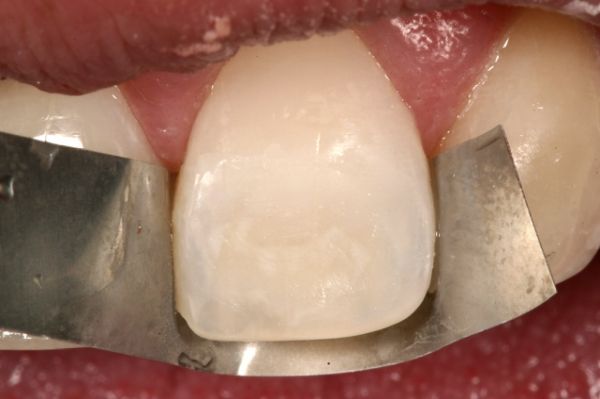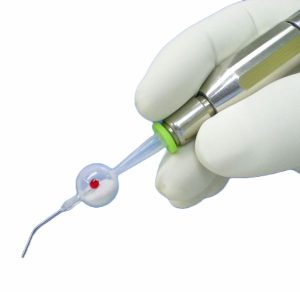Article By Greggory Kinzer on September 23, 2017
The intraoral sandblaster is a vital piece of armamentarium in my practice for nearly every adhesive clinical procedure, be it direct or indirect. The two main benefits of micro-etching are its ability to clean preparations and create micro roughness, both which help to increase bond strengths.1, 2
In general, any time I am going to bond a restoration (direct/indirect composite, veneers, partial coverage, full coverage), the first step in the bonding procedure is to micro-etch the preparation. Although there are other ways to “clean” the preparation, nothing is as effective or efficient as micro-etching.
Two key factors that must be addressed when using an intraoral sandblaster are protecting the adjacent teeth/restorations and protecting the soft tissue. Protecting the adjacent teeth/restorations is relatively easy. It is best done with either a rubber dam or some form of matrix, preferably metal.

Although using Teflon tape or a Mylar strip are other options, they are either hard to insert or difficult to hold in place during the procedure. Also, because of the nature of these materials, the sandblaster can more easily perforate them.
Protecting the tissue from micro-etching can be a little more difficult. If the tissue is not adequately protected, it is easy to create bleeding, which can be devastating for the bonding procedure.
The best way to protect the tissue is to again place a rubber dam, although depending on the margin location this can difficult. In situations with deeper margins, I resort to placing a retraction cord. Although this doesn’t completely alleviate the issue, it does help by displacing the tissue.
What also helps is the micro etcher that I use. For the past few years, I have been using the EtchMaster from Groman Dental (Fig 2).

This micro-etcher helps because it localizes the “spray” of the aluminum oxide in two ways.
First, the size of tip is very small so the direction of the spray can more easily be controlled. The other benefit of the small tip size is it helps limit the amount of over-spray.
Second, the tips come as a “unidose” product designed for one-time use, so the spray stays localized every time. The more times a traditional micro-etcher is used, the more the internal part of the tip itself becomes abraded by the aluminum oxide particles, so that over time the spray out of the nozzle becomes increasingly “wider.” Other benefits of the EtchMaster system are as follows:
The force of the micro etcher is controlled by the rheostat, as the system attaches to the connecter for the slow speed handpiece (Fig.3).
Multiple options available for both the “type” and “size” of particles.
The size of the unidose delivery units comes in both “small” and “large”
If you are practicing adhesive dentistry, make sure you are also micro-etching.

References
1. Flury S, Peutizfeldt A, Lussi A. Two pre-treatments for bonding to non-carious cervical root dentin. Am J Dent. 2015 Dec;28(6):362-6
2. Erkut S, et al. Effect of different surface-cleaning techniques on the bond strengths of composite resin restorations. J Prosthet Dent. 2014 Oct;112(4):949-56
EtchMaster adaptors are available from DPS: info@dpsdental.co.uk, www.dpsdental.co.uk, 01438 820550